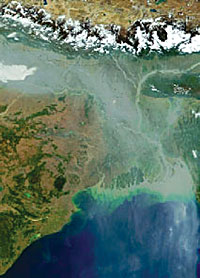 |
These are among the conclusions of scientists studying a more than three km-thick layer of soot and other man-made particles that stretches from the Arabian Peninsula to China and the western Pacific Ocean.
The team, drawn from research centres in Asia including China and India, Europe and the United States, announced their latest and most detailed assessment of the phenomenon in Beijing last week. The brown clouds, the result of the burning of fossil fuels and biomass, are in some cases and regions aggravating the impacts of greenhouse gas-induced climate change, says the report.
This is because ABCs lead to the formation of particles like black carbon and soot that absorb sunlight and heat the air and gases such as ozone which enhance the greenhouse effect of CO2. Globally however brown clouds may be countering or 'masking' the warming impacts of climate change by between 20 and up to 80 per cent, the researchers suggest.
This is because of particles such as sulfates and some organics which reflect sunlight and cool the surface. The cloud is also having impacts on air quality and agriculture in Asia increasing risks to human health and food production for three billion people.
Achim Steiner, UN Under-Secretary General and Executive Director, UN Environment Programme (UNEP) said: "One of UNEP's central mandates is science-based early warning of serious and significant environmental challenges. I expect the Atmospheric Brown Cloud to be now firmly on the international community's radar as a result of today's report".
The phenomenon has been most intensively studied over Asia. This is in part because of the region's already highly variable climate, including the formation of the annual monsoon, and the fact that the region is home to around half the world's population and is undergoing massive growth.
But the scientists today made clear that there are also brown clouds elsewhere, including over parts of North America, Europe, southern Africa and the Amazon Basin which also require urgent and detailed research.
"Combating rising CO2 levels and climate change is the challenge of this generation, but it is also the best bet the world has for Green Growth, including new jobs and new enterprises from a booming solar and wind industry to fuel efficient vehicles, homes and workplaces," said Steiner.
Prof Veerabhadran Ramanathan, head of the UNEP scientific panel which is carrying out the research said: "This report brings ever more clarity to the ABC phenomena and in doing so must trigger an international response-one that tackles the twin threats of greenhouse gases and brown clouds and the unsustainable development that underpins both."
One of the most serious problems highlighted in the report is the documented retreat of the Hindu Kush-Himalayan-Tibetan glaciers, which provide the headwaters for most Asian rivers, and thus have serious implications for the water and food security of Asia.
The new research, by identifying some of the causal factors, offers hope for taking action to slow down this disturbing phenomenon, but it should be cautioned that significant uncertainty remains in our understanding of the complexity of the regional effects of ABCs and more surprises may await us.


